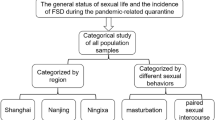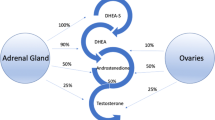Abstract
Epidemiologic investigations of women with female sexual dysfunction (FSD) from well-designed, random-sample, community-based populations are limited. Based on available information, FSD is common and estimated to occur in 22–43% of women. There are limited data on age-related and para-aging risk factors, which are critical to understand when planning treatment and prevention efforts. Based on correlates of FSD, associated risk factors include age, education, history of sexual abuse or sexually transmitted disease, overall state general happiness and physical health. This brief overview attempts to review what is known about the female sexual anatomy, describes factors that may affect female sexual responsiveness, and identifies several areas where additional research is needed to promote understanding of this complex physiological and psychosocial phenomenon.
This is a preview of subscription content, access via your institution
Access options
Subscribe to this journal
Receive 8 print issues and online access
$259.00 per year
only $32.38 per issue
Buy this article
- Purchase on Springer Link
- Instant access to full article PDF
Prices may be subject to local taxes which are calculated during checkout
Similar content being viewed by others

Author information
Authors and Affiliations
Corresponding author
Rights and permissions
About this article
Cite this article
Goldstein, I. Female sexual arousal disorder: new insights. Int J Impot Res 12 (Suppl 4), S152–S157 (2000). https://doi.org/10.1038/sj.ijir.3900596
Published:
Issue Date:
DOI: https://doi.org/10.1038/sj.ijir.3900596
Keywords
This article is cited by
-
Female Affective Perception of Mainstream and Paraphilic Pornography: Associations with Sexual and Psychological Intrapersonal Variables
Archives of Sexual Behavior (2024)
-
Sexual dysfunction and its associated factors among reproductive-age women at Gurage Zone, Southern Ethiopia, 2023
BMC Public Health (2023)
-
Smooth Muscle Organization and Nerves in the Rat Vagina: A First Look Using Tissue Clearing and Immunolabeling
Annals of Biomedical Engineering (2022)
-
Size matters: genital allometry in an African mole-rat (Family: Bathyergidae)
Evolutionary Ecology (2007)
-
Lower urinary tract disease: what are we trying to treat and in whom?
British Journal of Pharmacology (2006)


